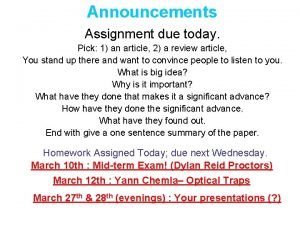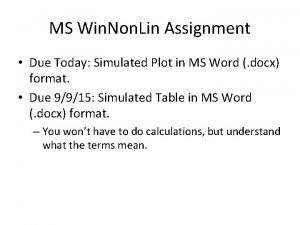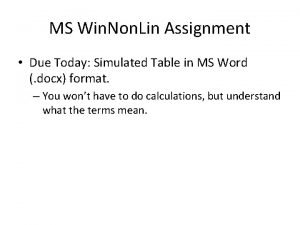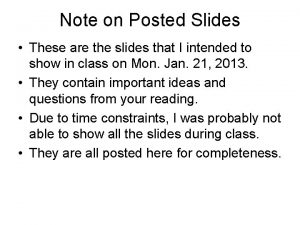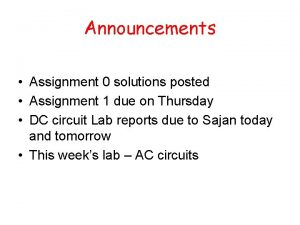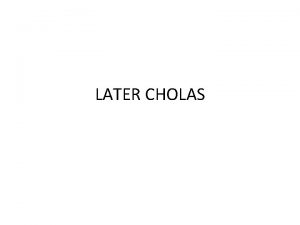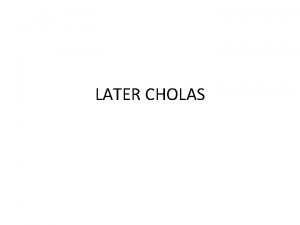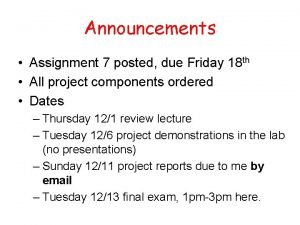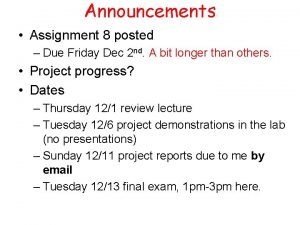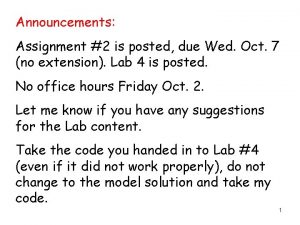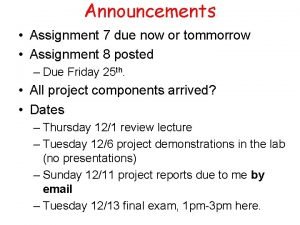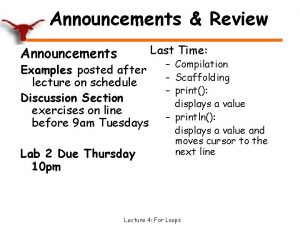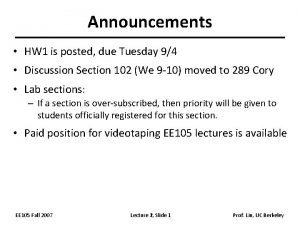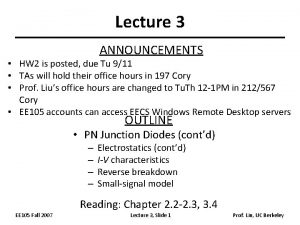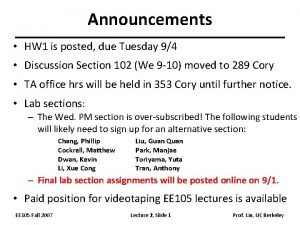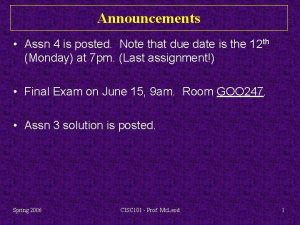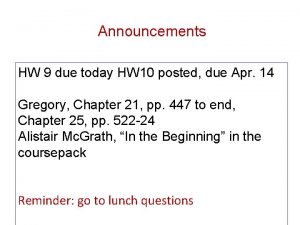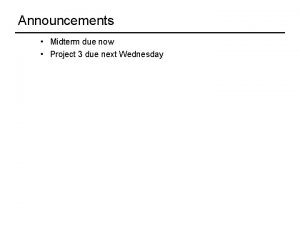Announcements Assignment 0 due now solutions posted later



















- Slides: 19

Announcements • Assignment 0 due now. – solutions posted later today • Assignment 1 posted, – due Thursday Sept 22 nd • Question from last lecture: – Does VTH=INRTH – Yes!

Lecture 5 Overview • Alternating Current • AC Components. • AC circuit analysis

Alternating Current pure DC V • pure direct current = DC • Direction of charge flow (current) always the same and constant. pulsating DC V • pulsating DC • Direction of charge flow always the same but variable • AC = Alternating Current pulsating DC V V • Direction of Charge flow alternates -V AC

Why use AC? The "War of the Currents" • Late 1880's: Westinghouse backed AC, developed by Tesla, Edison backed DC (despite Tesla's advice). Edison killed an elephant (with AC) to prove his point. • http: //www. youtube. com/watch? v=Rk. BU 3 a. Ysf 0 Q • Turning point when Westinghouse won the contract for the Chicago Worlds fair • Westinghouse was right • PL=I 2 RL: Lowest transmission loss uses High Voltages and Low Currents • With DC, difficult to transform high voltage to more practical low voltage efficiently • AC transformers are simple and extremely efficient - see later. • Nowadays, distribute electricity at up to 765 k. V

AC circuits: Sinusoidal waves • Fundamental wave form • Fourier Theorem: Can construct any other wave form (e. g. square wave) by adding sinusoids of different frequencies • x(t)=Acos(ωt+ ) • f=1/T (cycles/s) • ω=2πf (rad/s) • =2π(Δt/T) rad/s • =360(Δt/T) deg/s

RMS quantities in AC circuits • What's the best way to describe the strength of a varying AC signal? • Average = 0; Peak=+/ • Sometimes use peak-to-peak • Usually use Root-mean-square (RMS) • (DVM measures this)

i-V relationships in AC circuits: Resistors Source vs(t)=Asinωt v. R(t)= vs(t)=Asinωt v. R(t) and i. R(t) are in phase

Complex Number Review Phasor representation 2 2

i-V relationships in AC circuits: Resistors Source vs(t)=Asinωt v. R(t)= vs(t)=Asinωt v. R(t) and i. R(t) are in phase Complex representation: v. S(t)=Asinωt=Acos(ωt-90)=real part of [VS(jω)] where VS(jω)= A[cos(ωt-90)-jsin(ωt-90 )]=Aej (ωt-90) Phasor representation: VS(jω) =A (ωt-90) IS(jω)=(A/R) (ωt-90) Impedance=complex number of Resistance Z=VS(jω)/IS(jω)=R Generalized Ohm's Law: VS(jω)=ZIS(jω) http: //arapaho. nsuok. edu/%7 Ebradfiel/p 1215/fendt/phe/accircuit. htm

Capacitors What is a capacitor? Definition of Capacitance: C=q/V Capacitance measured in Farads (usually pico - micro) Energy stored in a Capacitor = ½CV 2 (Energy is stored as an electric field) In Parallel: V=V 1=V 2=V 3 q=q 1+q 2+q 3 i. e. like resistors in series

Capacitors In Series: V=V 1+V 2+V 3 q=q 1=q 2=q 3 i. e. like resistors in parallel No current flows through a capacitor In AC circuits charge buildup/discharge mimics a current flow. A Capacitor in a DC circuit acts like a break (open circuit)

Capacitors in AC circuits Capacitive Load "capacitive reactance" • Voltage and current not in phase: • Current leads voltage by 90 degrees (Physical - current must conduct charge to capacitor plates in order to raise the voltage) • Impedance of Capacitor decreases with increasing frequency http: //arapaho. nsuok. edu/%7 Ebradfiel/p 1215/fendt/phe/accircuit. htm

Inductors What is an inductor? Definition of Inductance: v. L(t)=-Ld. I/dt Measured in Henrys (usually milli- micro-) Energy stored in an inductor: WL= ½ Li. L 2(t) (Energy is stored as a magnetic field) • Current through coil produces magnetic flux • Changing current results in changing magnetic flux • Changing magnetic flux induces a voltage (Faraday's Law v(t)=-dΦ/dt)

Inductors Inductances in series add: Inductances in parallel combine like resistors in parallel (almost never done because of magnetic coupling) An inductor in a DC circuit behaves like a short (a wire).

Inductors in AC circuits Inductive Load (back emf ) from KVL • Voltage and current not in phase: • Current lags voltage by 90 degrees • Impedance of Inductor increases with increasing frequency http: //arapaho. nsuok. edu/%7 Ebradfiel/p 1215/fendt/phe/accircuit. htm

AC circuit analysis • Effective impedance: example • Procedure to solve a problem – – Identify the sinusoid and note the frequency Convert the source(s) to complex/phasor form Represent each circuit element by it's AC impedance Solve the resulting phasor circuit using standard circuit solving tools (KVL, KCL, Mesh etc. ) – Convert the complex/phasor form answer to its time domain equivalent

Example


Top: Bottom:
 If+past perfect+would have+past participle examples
If+past perfect+would have+past participle examples Pvu official announcement
Pvu official announcement R/announcements
R/announcements Church announcements
Church announcements What happened when montag crossed the ten-lane highway?
What happened when montag crossed the ten-lane highway? Kayl announcements
Kayl announcements General announcements
General announcements Now i see it now you don't
Now i see it now you don't Paper due now
Paper due now Assignment due today
Assignment due today Assignment due today
Assignment due today Assignment due today
Assignment due today Venule
Venule Figura geometrica con i lati disuguali
Figura geometrica con i lati disuguali Substantive vs procedural due process
Substantive vs procedural due process Pentacosiomedimni cavalieri zeugiti teti
Pentacosiomedimni cavalieri zeugiti teti Conservazione del moto
Conservazione del moto A food handler is reheating commercially processed cheese
A food handler is reheating commercially processed cheese The only completely reliable backflow prevention
The only completely reliable backflow prevention Posted
Posted









